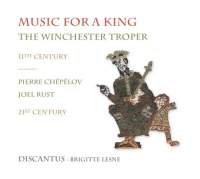Texte paru dans: / Appeared in:

Fanfare Magazine: 38:2 (11-12/2014)
Pour
s'abonner / Subscription information
Les abonnés à Fanfare Magazine ont accès aux archives du
magazine sur internet.
Subscribers to Fanfare Magazine have access to the archives of the magazine
on the net.
Aeon
AECD1436

Code-barres / Barcode : 3760058360361
The program for this album places it in Easter in 1043, when Edward Wessex, son of Æthelred the Unready, was crowned king at Winchester Cathedral. By one of those curious flukes of history we have an unusual insight into the music that was likely chosen for performance: a small but substantial manuscript that survives of a cantor’s work beginning in the 1020s, copying pieces that lay beyond the required chants for standard use. Included are both more sophisticated chants for Easter and processional works intended for such events as coronations. So while we can’t be sure all this music was employed to the Glory of God and Kings on that Easter of April 3—a moment’s peace, perhaps, for Edward, already planning to gather back power from his large, grasping family—we can surmise that at least a fair amount of this material was heard by him there.
This is the Winchester Troper, or at least, a part of one of its two manuscripts: a window that opens for us on a musical world during an intensely creative period of development, with a series of over 170 two-part tropes. They are as close as we are ever likely to come (along with Guido d’Arezzo’s Micrologus) to actual examples of European music’s polyphonic origins. The polyphony is typically vertical, meaning that both voices generally move together, but they don’t necessarily engage in parallel motion; and the second voice sometimes acts as a drone, returning to unison for the phrase’s close. Call and response isn’t notated in the manuscript, but it can be assumed to have taken place in at least some of the two-part tropes, and is used in such works as the Introit Postquam factus homo and the Sequence, an ecstatic Rex in aeternum. Much the same can be said of instrumentation, usually limited here to brief introductory small bells that establish the opening pitch or phrase—though they are reasonably employed for emphasis on the tone of many phrases in the celebratory laude Christus vincit and supply a polyphonic verse statement of over a minute at the opening of the hymn, O redemptor summe carmen. (The latter is referred to in the liner notes as one of three selections on the program that are monophonic chants, but the piece as performed here does make discreet use of two voices to good effect in strict parallel motion, and occasionally has a third part as drone.)
The inclusion of two modern works may prove a sticking point for some potential buyers. According to Discantus, the two composers were given “playing rules” that included writing for six women’s voices, utilizing excerpts from The Consolation of Philosophy by Boethius as their text, and composing within the context of an 11th-century context. The last’s the rub. It would be a rare 21st-century composer offered such a commission that didn’t deploy period devices or modes except in the broadest, most modern fashion, so as not to be accused of turning out ersatz-Gregorian chant and polyphony. But listeners who want the Winchester Troper sound world may not be pleased with the strongly modern flavor of Chépélov’s O qui perpetua, and Rust’s Sunt etenim pennae. If that’s the case, the 62:59 of enjoyable music on this album shrinks by 13:07 to 50:06.
That noted, I find the second major section of O qui perpetua, starting with “O qui perpetua mundum ratione gubernas,” especially attractive with its intoned passages in third under a wordless soprano in full flight, the harmonies much in the vein of Kodály’s wordless choruses. The opening section of Sunt etenim pennae, by contrast, is a beautiful solo passage whose ever-shifting polytonal characteristics are a musical play on the words, “Yea, I have wings to fly.” Both works are attractive, but whether they belong on a disc of 11th-century music must be for each person to decide for themselves.
I have nothing but praise for the performances of Discantus under Brigitte Lesne here, notable as usual for their disciplined intonation and phrasing, and beauty of tone. The text is enunciated with great clarity, despite the moderate cathedral-like resonance (which, for once, makes perfect sense in context). Lesne employs a recent edition of the Winchester Troper (based on Cambridge, Corpus Christi College, MS 473) by Professor Susan Rankin.
With texts supplied in the original Latin and Greek, and translations offered in English and French, this is a disc to treasure. Strongly recommended.
Cliquez l'un ou l'autre
bouton pour découvrir bien d'autres critiques de CD
Click either button for many other reviews


